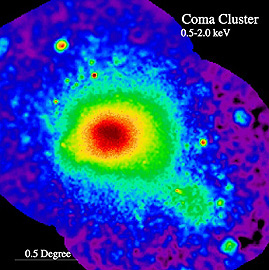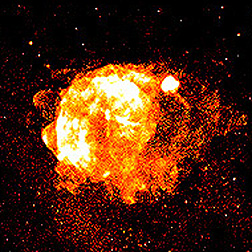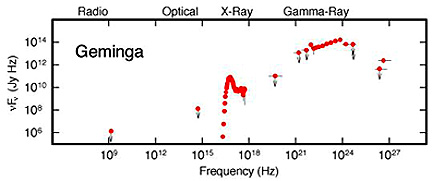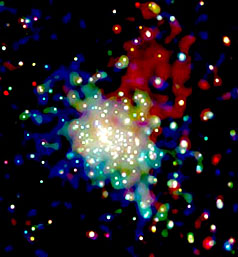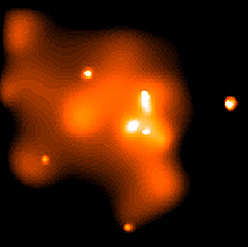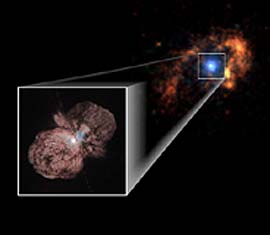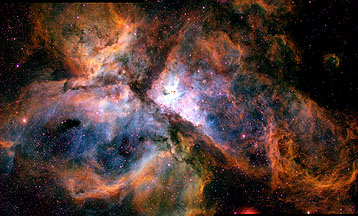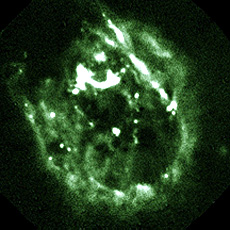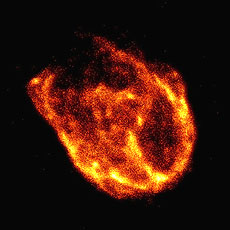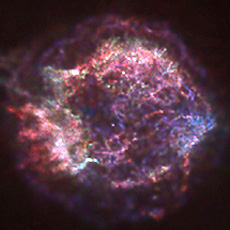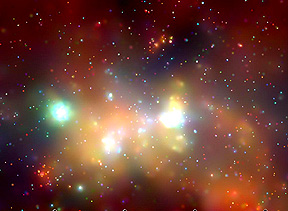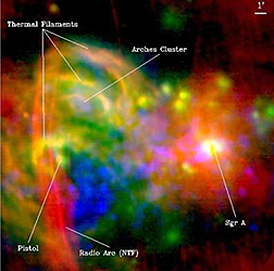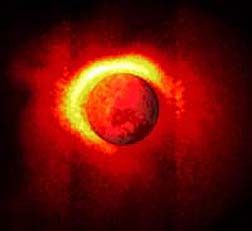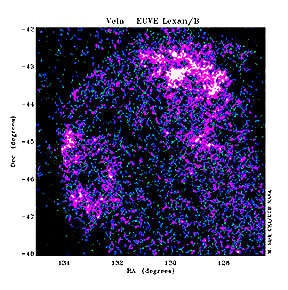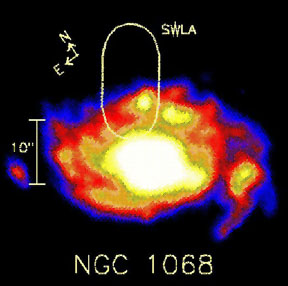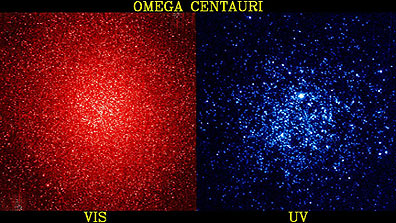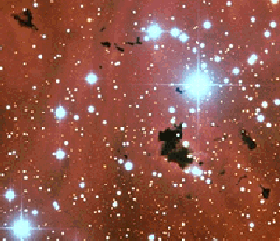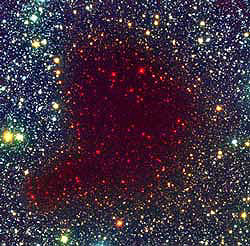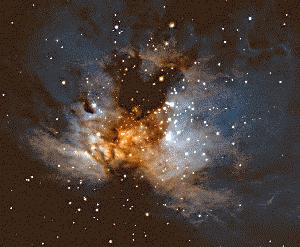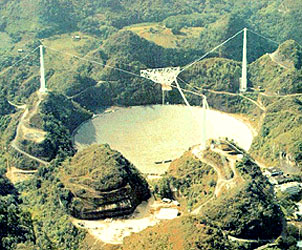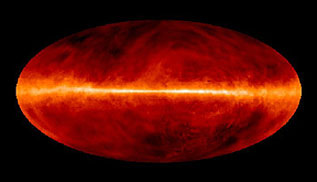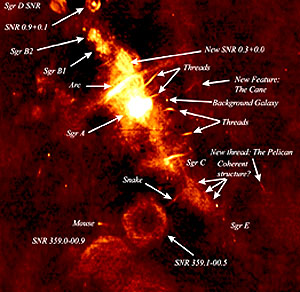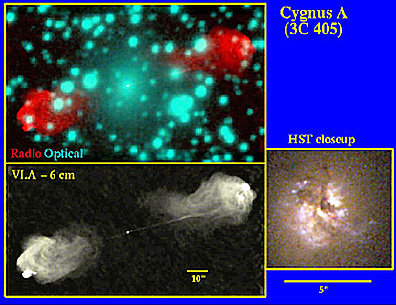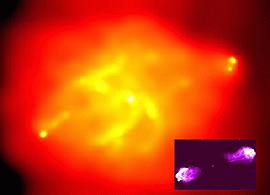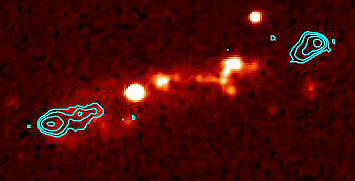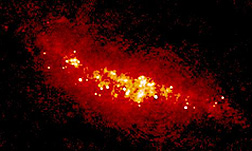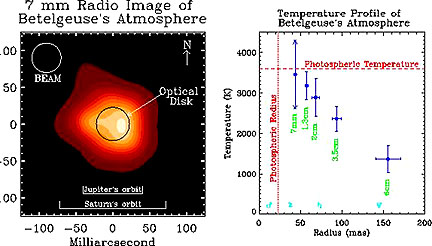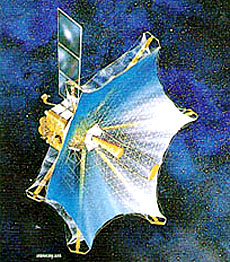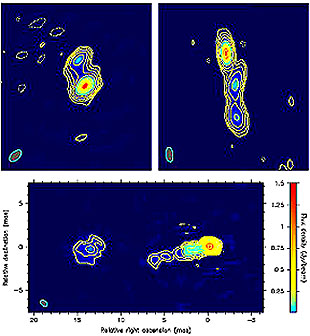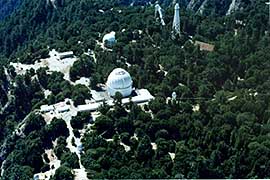Images of Galaxies and Stars outside the Visible Light Range.¶
Contents
Images of Galaxies and Stars outside the Visible Light Range.¶
Another valuable Internet site that has links to nearly all of the spaceborne telescopes and other instruments used for astronomical observations over the entire spectrum is at a site maintained by Danish Astronomers.
Most “star gazers” feel more comfortable looking at the luminous bodies of the Universe - stars and galaxies - as they appear in optical imagery. But, there is generally much more “illuminating” information about celestial bodies in images depicting energy distribution and intensity of radiation associated with other parts of the spectrum. The usefulness of examining bodies outside the Milky Way at different wavelengths was earlier demonstrated in the multispectral images of the Crab Nebula shown on page I-3 of the Introduction.
Astronomers at NASA’s Goddard Space Flight Center have assembled images taken at various regions of the spectrum by instruments (ground and space based telescopes, etc.) looking at our galaxy the Milky Way, as depicted in this montage (this is not a view of the M.W. taken externally but one looking towards its center and beyond towards its far edge; thus that part of the M.W. lying behind us [further from the center] is not included. Below, each image is identified by its imaging wavelength or wavelength interval of the spectrum, together with a brief description of the principal information that is associated with data collected from that region. Starting from the top:
(1)|Milky Way: showing its appearance as imaged by radiation from atomic Hydrogen.|
(1) Atomic Hydrogen (1420 Mhz): Picks out radiation from excited neutral hydrogen in interstellar gas and dust clouds.
(2)|Radio Continuum - Longer Wavelength|
(2) Radio Continuum (480 Mhz): Signal produced by fast-moving electrons; good for spotting sites of now diminished supernovae.
(3)|Molecular Hydrogen|
(3) Molecular Hydrogen (115 GHz): Shows distribution of molecular hydrogen associated with carbon monoxide in cold interstellar matter.
(4)|Radio Continuum - Shorter |
(4) Radio Continuum (2.4-2.7 GHz): Caused by high energy electrons and associated warm, ionized gases.
(5)|Far-Infrared.|
(5) Far-Infrared (12-100 µm): Radiation emanates from dust heated by stellar radiation; emphasizes active star-forming regions.
(6)|Mid-Infrared.|
(6)**Mid-Infrared (6.8-10.8 µm)**: Due to excitation of complex molecules in interstellar clouds and in cooler reddish stars.
(7)|Near-Infrared.|
(7) Near-Infrared (1.25-3.5 µm): Reveals temperatures, mainly of Giant, relatively cool stars, and shows the galactic core; dust is “transparent” in this spectral region and does not obscure many luminous features.
(8)|Visible region of the spectrum.|
(8)**Visible Light (0.4-0.5 µm)**: Displays primarily nearby stars and thin ionized gas; dark areas cold.
(9)|X-ray region.|
(9) X-Rays (0.25-1.5 kiloelectron-volts): Reveals gases heated by shock waves from supernovae.
(10)|Gamma-ray region.|
(10) Gamma-Rays (300 megaelectron-volts): Pinpoints high energy sources coming from pulsars or phenomena stemming from cosmic-rays.
More information about these images is presented at this Goddard Multiwavelength Astronomy site.
This idea of imaging cosmological entities at different wavelengths can be further enforced by looking at the montage of five views of the star Centaurus A in the wavelength regions indicated on each panel.
A point to be kept in mind in looking at images below, as well as on preceding and subsequent pages: Images acquired in any of the specific regions of the EM spectrum do not necessarily look the same - some may appear notably different than others because of the way in which the image is processed and displayed (for example, different filters may be used or the image values for intensity may be rendered in color-coded levels assigned different colors).
Now, some additional examples of observations in specific regions of the spectrum: First, let us look at high energy radiations in the X-ray region. The first image below shows the spiral galaxy M83 as it appears (in a colorized rendition) optically. Against this are contours of varations in x-ray intensities (given in units of keV [kilo-electron volts]) as measured by the joint U.S.- German Rosat (Roentgen Satellite) launched on June 1, 1990 to monitor the entire sky. Note the close-spaced contours around the galaxy center, but several other x-ray “hot spots” are also evident.
Several mechanisms account for this x-ray generation. Most prevalent is excitation into ionized states of intragalactic gases between stars or gases between galaxies that, in the tenuous void separating the stellar bodies, are traveling at such high velocities that they represent temperatures in excess of 1,000,000 °K capable of producing strong x-ray responses.
The second Rosat image portrays x-ray variations spread over the entire Coma supercluster, comprised of well over 1000 bright galaxies, located some 300,000,000 light years away. X-ray intensities vary from strong in reds to decreasingly weaker in greens to blues and purples. The interstellar gases emitting this radiation make up about 10% of the total mass of the supercluster, along with 2% more in the stars found in the individual galaxies as determined from optical measurements; the remainder of the mass is presently unaccounted for after inventories across the spectrum are related to their sources, so that the bulk of the mass is presumed associated with dark matter (see page 20-9). Thus, examining both galaxies and intergalactic regions using radiation at wavelengths both shorter and longer than the visible helps to quantify the distribution of the entire mass of the Universe.
On April 5, 1991 NASA launched the Compton Gamma Ray Observatory (CGRO) as a complement to the HST that extends coverage into the short wavelength, high energy end of the EM spectrum. It carried four instruments that could measure radiation whose energies range from 30 MeV to 30 GeV. This huge (central part nearly the size of a school bus) sensor platform has been one of the most productive astronomical observatories orbited so far. It is shown in this artist’s drawing:
The individual range of coverage by the CGRO sensors is shown in this plot:
The acronyms stand for BATSE = Burst and Transient Source experiment; COMPTEL = Imaging Compton Telescope; EGRET = Energetic Gamma Ray Experiment Telescope; OSSE = Oriented Scintillation Spectral Telescope. (The CGRO was named to honor Dr. Arthur Holly Compton, an eminent physicist, Nobel Laureate, and Chancellor of Washington University when the writer [NMS] was a graduate student there).
The CGRO was designed to measure radiation associated with stars and galaxies which result from high energy, usually nuclear processes. It looked particularly at supernovas, quasar and pulsar emissions, black hole accretions and other powerful stellar processes (next paragraph). CGRO discovered a new class of energetic objects, called blazars, that give off energy in the 30 MeV-30-GeV range.
One prime astronomical target of the CGRO was to search for Gamma Ray Bursts (GRBs), which are huge releases of energy that are short-lived and variable, are widespread in the celestial sphere and occur mainly in galaxies. Here is a map of those bursts measured over time by CGRO; the local effects of the Milky Way bursts have been removed. These GRBs will be discussed in more detail at the bottom of page page 20-6.
The Compton Gamma Ray Observatory was a major achievement guided by astrophysicists and operated by NASA Goddard. You can learn more about its results, with many additional images, at the CGRO site. On June 4, 2000 the CGRO was deliberatly decelerated so as to enter the atmosphere over the Pacific, as its orbital decay (adjustment fuel exhausted) meant it might fall to Earth at any time soon, possibly threatening populated areas.
A star in the Vela galaxy is a typical example. As seen by Rosat, it looked like this:
When variations in x-ray intensities are determined and displayed by color coding, this results:
CSRO provided this image in which the energy levels are color-shaded:
That energy spectrum can be quantified for this object, as shown in this plot:
A plot based on frequencies (which can be converted to energies) was obtained for the pulsar Geminga:
In September of 1999, NASA, guided by scientists from several nations, launched the Chandra X-ray (Telescope) (CXO). Named after the late S. Chandrasekhar, a reknown astronomer from India, Chandra is managed by the Marshall Space Center. Its length, when fully deployed, is 13.6 m (45 ft). It carries 4 sensors: a charge-coupled imaging spectrometer, a High Resolution camera, and High and Low Energy gratings.Its spatial resolution is 8 times greater than the best previous X-ray observatory and can pick out objects 20 times fainter as sources of x-radiation. Its astronomical targets include quasars, supernova and other high energy-emitting objects. Here is an example of an image of a ring of x-radiation associated with the remnants of a supernova in the Constellation Tucane:
Chandra has made images of regions of more recent star formations (sometimes as bursts) in the Milky Way. This one is striking indeed.
The Milky Way galaxy has a powerful x-ray source at its center probably associated with material infall into a Black Hole, as imaged thusly:
Imaging in the x-ray region of the spectrum commonly picks up a completely different picture of the object being imaged in the visible or other regions (see page I-3). This is exemplified by this artist’s reworking of the visible and x-ray renditions of Eta Carinae in the Milky Way galaxy. The Chandra view shows an outer ring of high energy particles not having any obvious counterpart in the HST image.
When the Carina nebula is imaged using narrow band filters, it looks like this. The blue image used to construct a color composite results from excitation of oxygen in the nebular gases; green represents hydrogen in this rendition; red is associated with sulphur ions.
We emphasize these points with these three views: Visible (top); X-Ray (middle); Radio Wave (bottom) segments of the EM spectrum, for a exploded star in the nearby Large Magellanic Cloud (a nebular satellite galaxy)
Because Chandra measures x-radiation from its targets over a range of wavelengths, individual elements which give off x-ray spectra at specific wavelengths can be detected and mapped. This has been done for the supernova Cassiopeia A. An HST optical image of this exploding star looks like this:
Here is a four panel set of Chandra images of Cassiopeia A (see alsopage 20-6). The upper left is color density map of the broad band radiation from Cassiopeia A. The upper right focuses on Silicon emission lines; the lower left on Calcium; and the lower right on iron. Thus Chandra is an adept tool for determining the distribution in the expelled material of various elements that were produced by nuclear burning in the star.
Chandra has imaged a stricking example of a bow shock wave developed in a cluster of stars in a small galaxy known as IE0657-6. Gases within the cluster are extremely hot, around 100 million degrees Centigrade. The bow shock (right side in the next image) was produced from a collision with a subcluster of stars whose gases were around 70 x 106 degrees C. In time much of the gases will be blown out from the present configuration.
Chandra has explored our Milky Way galaxy as well. This next image shows part of the central core region of the galaxy (about 400 light years wide) in which a number of very bright objects, seen in x-radiation, correspond to high energy emissions where interstellar gases are drawn into white dwarfs, neutron stars, and possible black holes. becoming continuously “ignited”.
A spectacular image of part of this central region was made by the Advanced CCD Spectrometer on Chandra:
In December of 1999, the European Space Agency launched an even more powerful x-ray telescope known as XMM-Newton (XMM stands for X-ray Multi-Mirror). Here are two colorized images, the first showing the variations in x-ray intensities in several of the Hickson group of stars and the second showing details of a supernova explosion in the nearby Large Magellanic Cloud:
XMM-Newton has demonstrated that large x-ray energy bursts also associate with the starbursts that mark development of young stars. Here is an image of NGC253, some 8 million light years from Earth; the inset on the left is a closer look at its center.
Satellites began to examine the UV region of the sky with the OAO series (OAO-3 was named Copernicus) in the late 1960’s. The follow-on International Ultraviolet Explorer (IUE) program began in 1978. Copernicus led to maps of bright UV stars such as this:
The ultraviolet (UV) region of the spectrum, from 70-2000 (0.007 - 0.2 µm) (Far) to 2000-4000 Angstroms (0.2 - 0.4 µm) (Near), has provided interesting images of stellar bodies, including the Sun. It also contains many diagnostic spectral lines helpful in determining elemental composition. This next image shows the Earth as imaged by EUVE (Extreme UltraViolet Explorer, launched in 1992 and operating until February, 2001; imaging from 70 to 760 Angstroms). It shows excited helium (yellow) and hydrogen (orange) in an auroral field extending well beyond the solid Earth.
Looking outward into space, the EUVE provided this image of the Vela Supernova:
One of the first UV telescopes is the IUE (International Ultraviolet Explorer) launched jointly by ESA and NASA in 1978; it operated into 1996. This is a UV image of the galactic source NGC1680:
The Ultraviolet Imaging Telescope (UIT) was flown as part of Astro-1 and Astro-2 lab packages on Shuttle STS-35 and STS-67 in the mid-1990s. The telescope covers the UV range between 1200 and 3200 Angstroms. It is particularly adept at recognizing hot, young stars which give out strong UV radiation. The difference in appearance between visible and ultraviolet images is pronounced in this UIT view of the galaxy M94:
This next image shows three galaxies in UV (top) and Visible (bottom); note the structure of the spiral arms as brought out by molecular hydrogen excitation
In this UIT image, the globular cluster Omega Centauri in visible light appears to consist of mainly red to orange stars, typical of older stellar bodies. But, the UV on the right shows that there are also many younger, hotter stars.
Launched on June 24, 1999, FUSE (Far Ultraviolet Spectroscopic Explorer) gathers spectra in the interval 910 - 1180 Angstroms. Excitation of molecular and elemental species in a star’s atmosphere or a galaxy en masse in this interval provides valuable information about stellar processes. Here is a typical spectral plot obtained by FUSE from observing a galaxy.
Observations through the FUSE telescope can be converted to images, such as this:
FUSE’s primary goal has been to trace the history of the early Universe by monitoring the distribution of hydrogen, deuterium, and helium in the intergalactic medium. Preliminary results indicate that helium, formed in the first minute of the Big Bang, and then dispersed during the expansion, will prove a sensitive indicator (it is also well monitored by FUSE) of the inhomogenieties in the expanding Universe following the initial explosion.
Thus, the UV is proving to be an optimum segment of the EM spectrum to study conditions in the so-called empty space which actually contains hot interstellar gas. CHIPS (Cosmic Hot Interstellar Plasma Spectrometer) is an astronomy satellite to be launched in December 2002. It will measure the diffuse extreme ultraviolet glow that will better define the properties and physical processes associated with the interstellar medium.
The UV carries to the Visible spectral range. Just beyond the Visible is the Infrared, extending from about 1 to 1000 µm. Much of the interval coincides with the thermal IR which you studied in Section 9. Hot stars are strong emitters in the IR and can be studied both as images and from their spectra. Other astronomical features amenable to IR observations include properties of accretionary disks and interstellar clouds, the structure of the H II type stars (those in an early stage of development that contain significant ionized hydrogen in the inner part of the hydrogen gas cloud that is the source of their nuclear fuel), and the dynamics of the Milky Way.
Small dark interstellar dust that obscures stars in the Visible are called Bok Globules (discovered by a Dutch astronomer of that name. They represent nebular gas and dust nearing the protostar phase (see page 20-5); such molecular hydrogen clouds are very cold (-263°C) and generally because of their small size (about a parsec) produce only one to several stars. These globules (some of which can be nearly spherical) stand out best in images that extend into the Near IR, as exemplified by this photo taken through the Anglo-Australian Telescope (AAT):
These two photos (acquired by ESA’s New Technology Telescope) show details of a Bok Globule in Barnard 68. The left image is made from three bands in the visible; the right image consists of bands at 1.25 µm = Blue; 1.65 µm = green; and 2.16 µm = red, which renders the cloud now transparent so that stars behind it become visible.
A galaxy (NGC2024) that is still largely shrouded by dust looks much like a visible image in this version made by the NICMOS camera on HST. The color composite consists of Blue = J band (1.6 µm); Red = K band (2.2 µm); and Green = J and K combined.
One of the first infrared-dedicated satellites was IRAS (Infrared Astronomical Satellite) launched in January of 1983. Its sensors were tuned to the 12, 25, 60, and 100 µm IR wavelengths. During its lifetime, IRAS discovered more than 350,000 previously undetected IR objects in the sky. This color composite of the interstellar “cirrus” clouds made up of gas and dust grains in the Milky Way that occupy a wide field centered on the North Celestial Pole is constructed from Blue = 12; Green = 60; Red = 100 µm.
On a grander scale, look at this IRAS image of the now familiar neighbor, the Andromeda Galaxy, with color-codes indicating variations in thermal emission at 12 µm.
IRAS obtained IR imagery of the Milky Way. In this next image, the central part of the galactic plane is displayed. Much of the yellows and oranges is thermal radiation from dust that obscures individual stars.
Other IR observatories have since been placed in space. ISO, the Infrared Space Observatory, was operated by ESA from November ‘95 until May ‘98. The instruments include an IR camera, a spectrometer, and a polarimeter. The spectral range was 2.5 to 240 µm. This is a colorized image of the Whirlpool Galaxy.
A short IR wavelength plot of radiation received from NGC6543 shows peaks correlated with argon, neon, hydrogen, and sulphur which occurs in the dust and gas nebula associated with this, the Antennae galaxy.
The star GL2591 is surrounded by a dense cloud. Spectra in the Short Wave IR interval sampled by IS0’s spectrometer disclose water ice, carbon dioxide ice and silicate particles in the dust grains within the enclosing material.
|SWIR Spectra from the dust sheath around Star GL2591. |
Infrared observations have also yield new information about very distant galaxies in the outer reaches of the Universe. This IR image shows, in the upper right, a glowingly-intense large galaxy located far out into the early Universe. The radiation intensity is believed to be related to energy released around a Black Hole (perhaps a quasar).
Astronomical objects, in particular galaxies and supernovae, emit the gamut of radiation across the spectrum. Galaxies are usually strong emitters of microwave radiation, in particular in the radio region. Radio waves are generated by excitation of neutral hydrogen. A good general review of radio astronomy has been prepared by the Haystack group at MIT.
The specialized field of radio astronomy utilizes large “dish” antennas to capture the long wavelength radiation. One of the first radio wave monitors is the famed Arecibo site in Puerto Rico, in which the parabolic receiver is embedded in a limestone sink in the jungle. The dish, 305 meters (just over 1000 ft) wide, is fixed in orientation and must use the rotation of the Earth to examine parts of the astronomical heavens.
The largest movable telescope in the world is the 100 meter radio antenna facility at Effelsberg in Germany. It can both rotate and swing up and down.
Resolution of 00000000000celestial targets from which radio waves emanate can be improved by developing a synthesized aperture by means of electronically hooking together individual radio telescopes. A major facility in the National Radio Astronomy Observatory group is the Y shaped array of 27 radio telescopes, each 25 m (81 ft) in diameter, located in the flats 70 miles west of Socorro, New Mexico. This creates an effective resolution of 36 km (22 miles). This Very Large Array (VLA) mode uses principles of Interferometry to process the signals from each telescope as a unit.
More background information on radio interferometry can be found at these Australian and Canadian Web sites. In essence, the same signals are received almost simultaneously at different receivers; when added together these may be out of phase and may cancel out or reenforce at specific wavelengths; computer processing allows a new interference signal to be produced.
Radio telescopes separated by hundreds and even thousands of kilometers can be tied together by electronic wiring or radio signals to each other to produce an array called VLBI (Very Long Baseline Interferometry). The effect of integrating the telescoope signals is to increase the resolution significantly, so that smaller features in radio objects can be discriminated.
One of the major tasks of radio astronomy was to survey the sky at 21 cm to pick up the distribution of neutral hydrogen in the Milky Way and the halo around our galaxy. Here is the result:
More details about the central region of the Milky Way appear in this radio telescope image made at 90 cm.
Whole galaxies are imaged at the 21 cm H wavelength. Here is M81:
In the early days of radio astronomy, many radio sources in deep space were discovered but when the same region was examined by optical telescopy often no obvious galaxy or other stellar body was found at first. Later observations at non-radio wavelengths have now detected the astronomical feature, usually a galaxy (many galaxies are very strong radio wave emitters). One of the best examples of powerful energy emitters in which visible images do not detect any obvious sources is Cygnus A, from a galactic center about 700 million light years away. Cygnus A is the strongest radio wave emitter in our part of the Universe. Consider these images:
In the above image, the upper left shows a visible light image (star groupings in bright blue) but with no obvious galactic shape; however as colorized in red are two distant lobes representing radio wave signals associated with Cygnus A. The lower left image is another radio wave rendition of signals received at 6 cm. The lower right, made by HST, reveals some strong radiation coming from the central region of Cygnus A.
When that region is examined through a ground-based x-ray telescope, again it shows below as an expanded area of matter giving off high amounts of energy at short wavelengths. The inset at the lower right is another radio wave image (note that there is a corresponding area for each lobe in the x-ray image.
Here is a galaxy seen in the Infrared, on which is superimposed the intensity contours associated with two radio sources in the limbs that once seemed isolated from this distinct galaxy.
This next image shows an L-Band image of the Starburst Galaxy; this was made at the Jodrell Bank Radio Telescope Observatory near Manchester, England, one of the premier facilities in the field. The signals were obtained from the MERLIN (Multi-Element Radio Linked Interferometer Network).
A longer wavelength radio image acquired by the MERLIN VLBI system shows the binary star pair SS433. Contour lines show the extent of radio wave activity outside the central region occupied by the star pair.
The Red Giant Star Betelguese (see next page) has been imaged within the microwave region (outside the main radio interval) at 7 mm. Under these conditions it was possible to measure a temperature profile (right) in the expanded gas envelope (photosphere) around the star.
Supernovae (see page 20-6) are strong sources of radio waves. They expand so rapidly that time lapse images taken months apart can monitor their spread and the changes in shape of the radio wave field. Here is such a sequence for Supernova SN1993J in the galaxy M81. The images on the left were taken at 3.6 cm; those on the right at 6.0 cm.
The reader might have had a thought during this review of radio astronomy: Why not put a radio telescope in space? But, wouldn’t the antenna be much larger than is commonly on satellites. The answer is “No” if the VLBI concept (above) is employed. The Japanese Space Program has developed and launched HALCA (Highly Advanced Laboratory for Communications and Astronomy) in February 1997 as the kingpin in their VSOP (VLBI Space Observatory Project) program. The radio satellite has a 25 m antenna and looks like this:
HALCA’s orbit is elliptical, with its perigee (closest approach) at 1000 km and apogee (farthest) at 20000 km. When coupled electronically with one or more radio telescopes on the ground, the effective diameter of the joint system is greater than that of the Earth itself (12755 km). This creates a very high resolution radio wave detector (in some applications, 1000x better than the HST) when used in the Interferometer mode. Although HALCA experienced some trouble in 1999, it did send back considerable data and proved the concept of using multiple integrated radio receivers to achieve exceptional resolution. Here are three images of quasars (see page 20-6) at considerable distances from Earth that illustrate one of the ways in which HALCA data can be displayed:
Plans to put other radio telescopes in space are now active. Principles behind using multiple radio telescope satellites, in formation flying, to increase resolution are examined on JPL’s Starlight program site.
Since we have introduced the specialized technique of interferometry on this page, it is now appropriate to revert back to imaging in the visible spectrum to mention the CHARA (Center for High Resolution Astronomy; operated by Georgia State Univ. astronomers) project which is now commencing operation at the famed Mt. Wilson Observatory (in the mountains north of Los Angeles), shown here:
The large central observatory dome houses the famed 100 inch Hooker telescope that Edwin Hubble used to track down galaxies outside the Milky Way and to measure redshifts, laying the foundation for the Big Bang model. In the above picture are several of the 6 auxiliary optical telescopes tied to the main telescopes. Working in pairs, and later in larger combinations, light from separate components of the array must be combined and synchronized to produce interferometric images in which the waves reenforce rather than cancel. This multiple system produces a baseline (at optimum, 1080 feet) that greatly increases the angular resolution of the central telescope, thus providing images that are expected to exceed the Hubble Space Telescope in sharpness. To get the signals from two or more telescopes into coincidence (the light arrives at any two pairs at slightly different times), one beam is sent through an optical pipe that contain movable mirrors mounted on rails (the “delay line”). The mirror(s) are moved until the extra distance traveled by light to the second telescope (relative to the first) is just compensated enough (equalized) to bring the two signals into phase. This delicate adjustment is made through a computer program that controls pathway adjustments.
With this examination of space observatories that collect data over different parts of the spectrum, we now return to the exposition of aspects of Cosmology by looking at the origin and evolution of individual stars.



